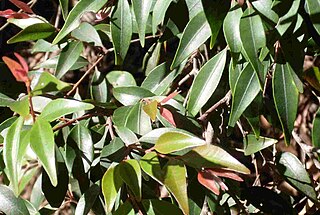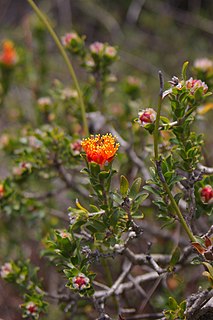
Myrtaceae or the myrtle family is a family of dicotyledonous plants placed within the order Myrtales. Myrtle, pōhutukawa, bay rum tree, clove, guava, acca (feijoa), allspice, and eucalyptus are some notable members of this group. All species are woody, contain essential oils, and have flower parts in multiples of four or five. The leaves are evergreen, alternate to mostly opposite, simple, and usually entire. The flowers have a base number of five petals, though in several genera the petals are minute or absent. The stamens are usually very conspicuous, brightly coloured and numerous.

Backhousia is a genus of thirteen currently known species of flowering plants in the family Myrtaceae. All the currently known species are endemic to Australia in the rainforests and seasonally dry forests of Queensland, New South Wales and Western Australia.

Lophostemon is a genus of 4 species of evergreen tree in the myrtle family Myrtaceae. All four species are native to Australia, with one extending to New Guinea. The genus was first described in 1830 but not widely recognized until the 1980s. All 4 species were previously included in the related genus Tristania.

Uromyrtus is a genus of plants in the myrtle family Myrtaceae described as a genus in 1941. The greatest diversity of species are found in New Caledonia and the remainder are found in Australia, New Guinea and Borneo.

Tristaniopsis is a group of shrub and tree in the myrtle family Myrtaceae described as a genus in 1863. They have a wide distribution in Southeast Asia, New Guinea, New Caledonia and Australia.

Syncarpia glomulifera, commonly known as the turpentine tree, or yanderra, is a tree of the family Myrtaceae native to New South Wales and Queensland in Australia, which can reach 60 metres in height. It generally grows on heavier soils. The cream flowers appear in spring and are fused into compound flowerheads.

Xanthostemon is a genus of trees and shrubs, constituting part of the myrtle plant family Myrtaceae. This genus was first described in 1857 by German–Australian botanist Ferdinand von Mueller. According to different official sources between 46 and 51 species are known to science. They grow naturally in New Caledonia, Australia, the Solomon Islands and Malesia, including the Philippines, New Guinea and Indonesia. The genera Pleurocalyptus and Purpureostemon from New Caledonia are morphologically close to Xanthostemon.

Eremaea is a genus of woody shrubs and small trees in the family Myrtaceae and is endemic to the south-west of Western Australia. Little study of the genus as a whole had been undertaken until Roger Hnatiuk researched Eremaea and published a paper in 1993, A revision of the genus Eremaea (Myrtaceae) in Nuytsia. The first species to be described was Eremaea pauciflora in 1837 and by 1964, the number of species known had increased to 12. Hnatiuk recognised 16 species, 5 subspecies and a number of varieties.

Gahnia is a genus of sedges native to China, Southeast Asia, New Guinea, Australia, New Zealand and a number of Pacific Islands. The common name is due to the toothed margins. It often forms tussocks.

Angophora floribunda, commonly known as the rough-barked apple, is a common woodland and forest tree of the family Myrtaceae native to Eastern Australia. Reaching 30 m (100 ft) high, it is a large tree with fibrous bark and cream-white flowers that appear over the Austral summer. It grows on alluvial soils on floodplains and along watercourses. Much of the land it grew on has been cleared for agriculture.

Backhousia subargentea is a rare Australian rainforest tree, growing near Mullumbimby in north eastern New South Wales and from Boonah to Imbil in south eastern Queensland.

Xanthostemon chrysanthus, the golden penda or first love, is a species of tree in the myrtle family Myrtaceae, endemic to north eastern Queensland, Australia. It is a popular garden plant with showy yellow blooms.

Gossia is a genus of rainforest trees in the myrtle family first described as a genus in 2003. It is native to northeastern Australia as well as several islands of Papuasia and New Caledonia.

Xanthostemon verticillatus is a species of trees from the plant family Myrtaceae endemic to the Wet Tropics rainforests of northeastern Queensland.
Barongia is a genus of flowering plants in the myrtle family, Myrtaceae first described as a genus in 1988. It contains only one known species, Barongia lophandra, endemic to the Cook region of Queensland, Australia.
Kjellbergiodendron is a genus of the botanical family Myrtaceae, first described as a genus in 1936. It contains only one known species, Kjellbergiodendron celebicum, endemic to the Island of Sulawesi in Indonesia.
Ochrosperma is a group of shrubs and small trees in the myrtle family Myrtaceae described as a genus in 1987. The genus is endemic to Australia.
- Ochrosperma adpressumA.R.Bean - Queensland
- Ochrosperma citriodorum(Penfold & J.L.Willis) Trudgen - New South Wales
- Ochrosperma lineare(C.T.White) Trudgen - Queensland, New South Wales
- Ochrosperma obovatumA.R.Bean - Queensland
- Ochrosperma oligomerum(Radlk.) A.R.Bean - New South Wales
- Ochrosperma sulcatumA.R.Bean - Northern Territory

Pleurocalyptus is a group of shrubs and small trees in the family Myrtaceae, first described as a genus in 1868. The entire genus is endemic to New Caledonia. It is closely related to Xanthostemon.
Purpureostemon is a genus of plant in the myrtle family Myrtaceae described as a genus in 1939. There is only one known species, Purpureostemon ciliatus, endemic to New Caledonia. Purpureostemon is related to Xanthostemon.
Syzygium apodophyllum is a tree in the Myrtaceae family endemic to north Queensland. The fruit is edible. It is a host for the exotic plant-pathogen fungus Austropuccinia psidii, which is causing a lot of damage to vegetation communities and economic plants.














